Mega Man: Rock Beats Scissors, Get It?
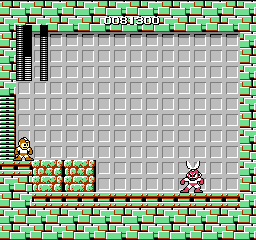

Mega Man was, I think, the first game to introduce non-linearity in an action-platformer context. Perhaps Metroid did it sooner, but Metroid was primarily an adventure game -- Mega Man was a true left-to-right action game. This style also offered a sort of built-in difficulty setting: the standard order of Guts-Cut-Elec-Ice-Fire-Bomb gave you a "normal" gameplay experience, allowing you to have every boss' weakness (except Guts Man), and if you picked it up in Elec Man's stage, the utiliy of Magnet Beam to get through some of the more difficult parts of the other stages, such as the disappearing blocks in Ice Man's stage. Of course, if you were looking for more of a challenge, you could play the stages in any order, deliberately ignoring any advantage that would make the game easier. Buster-only runs remain a favorite of self-imposed difficulty.
Despite the quality of the game, though, it was first met with a somewhat lukewarm reception. It's funny to say it now, but Mega Man's origins are that of a "cult classic" or "sleeper hit" -- unlike many other things that fall into those distinctions, though, it got a sequel that broke that mold.
Mega Man 2: Dr. Wily Strikes Again, Mega Man Not Surprised; Feels It May Become A Trend
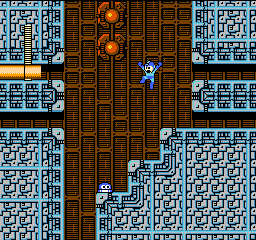

Not without resistance from Capcom, though: Keiji Inafune and his team desperately wanted to make Mega Man 2, but the sales of the original had Capcom hesitant. Instead of waiting to get a green light, they just went ahead and made the game during off-hours. It's well-documented how Mega Man 2 was a true labor of love, and that's something you don't see in video games. Maybe once every few years.
Mega Man 2 introduced E-Tanks, which completely restore your health when used, and "Items," which are tools you can use as platforms for getting over certain obstacles. It also upped the robot master count from 6 to 8. MM2's gameplay is somewhat of a gold standard for not only the rest of the series, but for 2D platformers in general -- its underlying mechanics are so solid that it doesn't feel one bit archaic even today.
Of course, the rest is history: Mega Man 2 is widely considered one of the greatest games ever created, the soundtrack among the finest composed, Keiji Inafune becomes a gaming legend.
Mega Man 3: Lying Down And Kicking Your Legs Makes You Move Faster
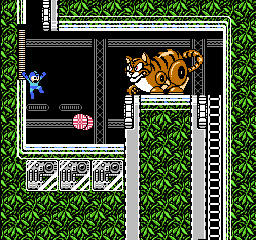

Another successful sequel, Mega Man 3, didn't hurt things, either, with its silky smooth slide mechanic that melded perfectly with the run and gun gameplay of the series. It further built upon its predecessors by tweaking MM2's Items, replacing them with various functions of Rush the Dog, such as Coil, Jet and Marine. It was also the first game in the series to feature more than a few post-robot master stages, adding four "ruined" versions of Gemini Man, Spark Man, Needle Man and Shadow Man's stages. Perhaps most surprising about these stages is how punishingly difficult they were -- you had to re-fight MM2's robot masters within them, two per stage, and they were both significantly more difficult than their original incarnations (Especially Wood Man and Air Man).
There were other new additions in MM3, too, like the introduction of sub-bosses: the cats in Top Man's stage, Break Man's appearances in Shadow Man and Hard Man's stages, and the giant snakes in Snake Man's stage.
I always found it odd that so many people prefer MM2 to 3 considering how much more stuff there is in 3, all of it good. The level design, if you ask me, is a lot better in 3 as well.
Mega Man 4: Now With Kamehameha Power
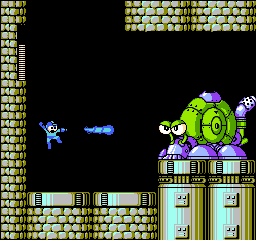

The charge shot, introduced in Mega Man 4, created a sort of divide within the series: the perception was that, from 4 on, the charge shot shifted the focus from tricky platforming to simply destroying enemies. This is false, I would say, and I say that because MM4 had some of the more difficult platforming segments in the whole series, certainly much harder than anything in MM2 or 3, save Heat Man's disappearing block sequence. It was more in line with what you saw in MM1: segments of levels where falling off a platform would mean death, and the enemy spawns were designed to make that happen.
Sure, you saw this in the previous two games, but it was abbreviated and simple to overcome. In MM4, you have the swinging platforms in Bright Man's stage, where shooting one of the enemies who constantly assaults you would turn off the lights -- and while it doesn't hide anything important from view, it's disorienting nonetheless. You have the trash compactor sequence in Dust Man's stage which is very easy to get trapped in, leading to an instant death. Then there's a particularly brutal part of Drill Man's stage where you have to hit switches to make the next piece of land appear, all the while you're being pummeled by falling rocks and flying robots. Just about every stage in the game has at least one sequence like this, including the Cossack and Wily stages.
One other thing MM4 added to the formula were secret paths found in Pharaoh Man and Dive Man's stages, leading to hidden powerups -- the Balloon and the Wire. The Balloon was essentially a resprited version of Item 2 from MM2 -- very useful. The Wire allowed you to cling to the ceiling and shoot from that position... sounds like it might have been useful if there were levels designed to utilize it, but I guess that was hard to do since it was optional.
Mega Man 4 is a great game. Yeah, I said it. Pound for pound, I'd say it's a better game than MM2. The boss fights are almost all difficult with the buster and fairly easy with weaknesses -- a mark of good balance. The level design is very good, the difficulty is high (but fairly so) and it was the longest game in the series at the time. The arguments I hear for it being a bad game are almost entirely superficial nonsense like "the robot masters are lame" (which they're not) and "the music isn't that good" (which it is). Stop hating, MM4 is really, really good.
Mega Man 5: Why Did I Bother Killing These Robot Masters Again?
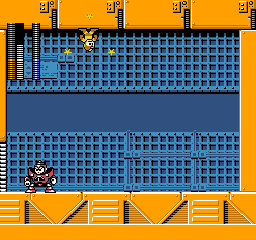
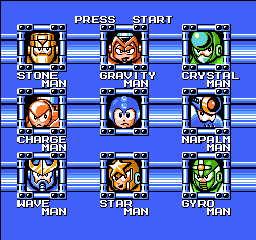
But there's still five more games in this series, right? Right. Mega Man 5 is interesting, because it retains the quality of MM4, expanding on the optional items concept, introducing eight letters which spellout "MEGAMANV" when collected, unlocking Beat, a bird who attacks enemies on screen. The level design remained very good -- highlights include the gravity switching sequences in Gravity Man's level and the ascending elevator sequence of Gyro Man's level.
The "interesting" part comes in because there's a pretty big problem. The robot master weapons. They are all terrible. In all four previous games, maybe two or three of the weapons weren't very useful, but MM5 took the cake -- there's only one weapon in the entire game worth using outside boss fights, and that's Gyro Attack. Other weapons are functionally broken and/or useless, such as Water Wave and Power Stone. The others are just terribly mediocre -- Gravity Hold sounds like a good idea, but it uses way too much energy and takes too many hits to kill anything. Star Crush has maybe one use, and that's getting through the sequence of Crystal Man's stage where crystals fall from the ceiling, and that's only if you have a horrible sense of timing. Charge Kick is a unique weapon, and would have been great if it provided more invincibility frames and a faster/longer dash, as well as doing more damage.
MM5 is the first game in the series that's actually justifiable to dislike. One other flaw it has is that the boss fights are, in general, very easy, and most of them are beaten with the standard Mega Buster very easily. In fact, in most cases, using the Mega Buster is faster than using any of the special weapons.
Still, the level design is solid and the music is good. It's not a bad game. You know what is a bad game?
Mega Man 6.
Mega Man 6: Americans Help Japan Create Robots, World Sighs
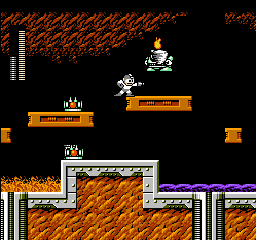
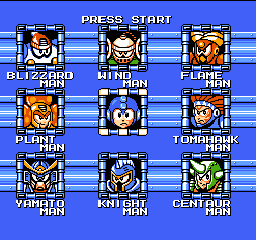
MM6 suffers from all the problems MM5 did: easy bosses, terrible weapons. However, it adds to those problems by removing the ability to jump out of slides. If you're unfamiliar with this, in every Mega Man game besides 6, if you slide, let go of the d-pad and press A, you'll jump. In MM6, it no longer works. This makes the game painful to play if you've become accustomed to doing this, especially for speedrunners who rely on this for saving time. If you watch Tiki's run at SDA, you can see him sliding, moving backward briefly and then jumping. That is a pain in the ass.
In this game, you replace Gyro Attack with Flame Blast. It's the only decent weapon in the whole game. It's sad, because there were a lot of promising improvements: instead of having Rush's functions, you get actual "adapters" for Mega Man which change the way he fundamentally plays -- the Jet Adapter allows you to fly for a few seconds, and the power adapter allows you to break certain barrels and do more damage with your shots, at the cost of greatly reduced range.
Still, that wasn't enough to save it. On top of that, the robot masters actually were lame this time, and the music wasn't that good. At around this time, people had been fed up with NES Mega Man games being released while the SNES had been out for a couple years.
Mega Man 7: Bass, Like The Fish, Right?
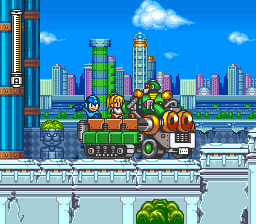
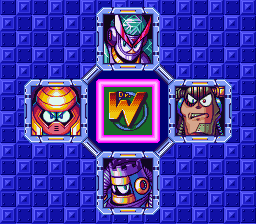
Mega Man 7, as I recall, came out somewhat under the radar. I saw it at Blockbuster one day and rented it. Didn't even know it was released.
MM7 is a return to form of sorts. It's like MM5 with better weapons plus MM6's adapter system, with the sliding mechanic fixed. Though the weapons don't get back to the point of MM2-4 where most of them were good, they at least found a new use for them: manipulating the environment. You can use Thunder Bolt to power machinery in Junk Man's stage, Scorch Wheel to burn a forest in Slash Man's stage and a couple other things. Junk Shield is by far the best shield weapon in the series to this point, and the other weapons are, for the most part, unique at least.
The Jet Adapter returns, which you get by collecting the "RUSH" letters in four of the stages. It also allows you to use the "Super Arm," which is like a powered up version of the Mega Buster -- instead of firing a blast, you fire Mega Man's arm at the enemy. This was carried over from Mega Man 5 Gameboy.
Also carrying over from the Gameboy games is the structure of progression: instead of all eight robot masters being available at the start, you have to beat the first four, play an intermission stage, then the other four become available. This detracts from the non-linearity of the game in order to, I'm guessing, add more to the narrative structure of the game -- a big mistake. Carrying over from the X series is the inclusion of a fairly redundant intro stage which, again, I can only imagine was included to add more to the story. This, really, is the only thing keeping it from being one of the better games in the series. Instead, it just sits somewhere in the middle.
Mega Man 8: OR: Coolboarders 20XX
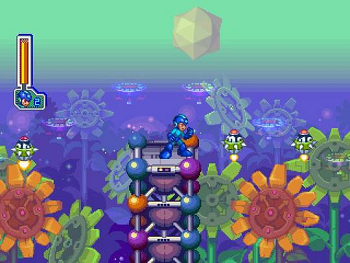
Mega Man 8 was the first game in the classic series not released on a Nintendo console, residing on Sony's Playstation and Sega's Saturn. It shared a lot of the same problems MM7 did -- redundant intro stage, four robot masters at a time, an attempt to shove a story down the throats of people who didn't need or want one. This resulted in the now infamous Dr. Light voice acting. You know, where he sounds like Elmer Fudd? Great comedy, but a good indication that Capcom wasn't quite in touch with what people wanted out of a Mega Man game.
It played nicely, though. I would definitely say that, gameplay-wise, this was the "true" return to form. The level design was clever, the bosses were difficult, and the music was incredible, dropping the 8-bit rock-influenced style for a refined drum and bass/electronic sound with some jazz thrown in. Musically, it's by far the most mature soundtrack in the series.
What most people will remember about MM8 is probably the echos of "JUMP JUMP SLIDE SLIDE" ringing through their ears. The incredibly frustrating portions of Frost Man's stage and Wily 1 have you riding a rocket-propelled snowboard over elevated platforms while a shrill, robotic voice tells you when to jump and when to slide. It gets very confusing when the speed picks up. Tengu Man's stage has you riding Rush through an autoscrolling segment which ultimately amounts to a sidescrolling shmup stage. In Aqua Man's stage, Mega Man actually swims for the first time.
The weapons this time range from average to good, with Flash Bomb being particulary powerful. Astro Crush is good in a pinch for killing everything on screen and the invincibility frames. Thunder Claw allows you to swing across gaps provided there's something for it to latch onto. Tornado Hold is useful for puzzles in Sword Man and Astro Man's stage, as well as getting yourself up high ledges. There's also the Mega Ball, acquired in the intro stage, which is pretty much what it sounds like: fire once to drop a ball in front of you, again to kick it. Overall, there's not really any useless weapons in the arsenal. Mediocre at worst.
The difficulty of the game is actually higher than normal, partly because there are no E-Tanks, and partly because the game was just designed that way -- enemy spawns are devious, and some bosses are just plain hard to hit (Wily 1 in particular).
Despite annoyances with the storyline being forced, MM8 was a very good game -- the best since MM4. Before I talk about MM9, though, there's one lesser known game to tackle...
Mega Man & Bass: Oh, Like Bass And Treble? That Makes More Sense, Yeah
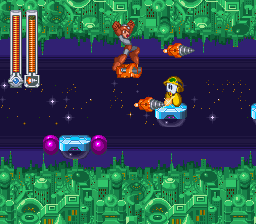
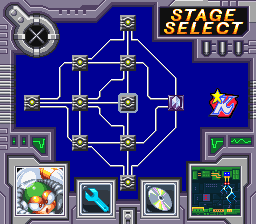
Mega Man & Bass takes MM8's graphical style and downgrades it to SNES/GBA hardware. It works out surprisingly well -- there's just some frames of animation missing, and overall it looks pretty good for what it is. They also re-used two robot masters from MM8: Tengu Man and Astro Man. I'm not really sure why. Laziness, I guess.
The whole premise of the game is that Mega Man and Bass have teamed up to stop King, some megalomaniac robot who is totally not a pawn for Dr. Wily who will end up being the true final boss. Naturally, you can actually play as Bass if you wish -- and he's actually very different from Mega Man. He can dash, like in MMX, by double-tapping left or right. He can also shoot in several directions, though initially, his shots are weaker than Mega Man's. He can double jump, which makes getting through the stages a lot easier as Bass. I like to think of Bass as "easy" and Mega Man as "hard."
Either way, though, this game is balls hard. The bosses are by far the most difficult in the entire series. There are no E-Tanks, much like MM8. Unlike MM8, though, a good amount of the bosses will absolutely hand you your ass even with their weaknesses. Burner Man, Dynamo Man and Astro Man are rough, namely. They will, however, reward you with some of the best weapons in the series.
Wave Burner is horribly powerful, killing just about anything in less than a second. Remote Mine is similar, but you can direct where it goes and then tell it when to explode. Lightning Bolt is pretty much identical to Astro Crush, but it has a lot more energy. Tengu Blade is very strong, and you can attack while dashing/sliding with it. Magic Card isn't that strong, but you can grab items and stuff with it. Ice Wall is also very strong, and you can use it as a platform to get to higher areas.
I dunno why every Mega Man game can't have weapons like this. Even the "bad" weapons, Copy Vision and Spread Drill, have their uses.
Anyway. Again with the intro stages -- at least this time it's kind of interesting, paying homage to past games in the series (Metal Man's screws, Fire Man's falling flames and fire pillars, Blizzard Man's rising/sinking ship-thing, Toad Man's rainy area). At the end you fight the Green Devil from MM8.
The way you progress in this game takes the linearity to a new level -- this time, you only have access to three bosses, and beating each one opens more, so there's a definite order you're sort of forced into.
I'll be honest: I have never gotten past the second King stage in this game. It's hard. Mega Man & Bass is harder than Mega Man 9, by a lot. It's also a lot of fun if you can handle it, has good, if different music, and some of the most fun weapons in the series. I talked about that more than I thought I would.
Mega Man 9: Like, Ten Years Later
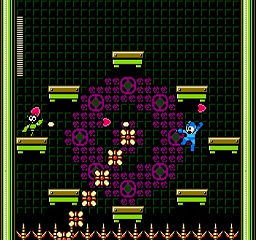
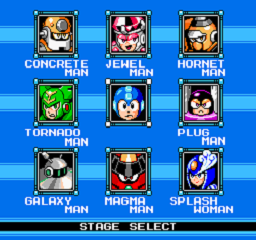
At this point, everyone had accepted that while 7 and 8 were good, MM2 and 3 would never be surpassed, and that the classic series, which hadn't seen a new game in ten years, was done. Then there was Mega Man 9. You know the story: It was 2008, and MM9 was an NES game. Madness, etc. I really, really liked it.
Some people said it would be comparable to an MM2 ROM hack, but that couldn't be farther from the truth -- it was a totally fresh experience, even with the stripped down skillset and dated graphics. The level design was fantastic and creative, the music was the best in the series and the weapons were all good. Every single one of them.
Jewel Satellite is by far the best shield weapon in the series, and every other weapon dominates in some way or another: Concrete Shot vs. sub-bosses, Black Hole Bomb vs. normal enemies, Tornado Blow for clearing rooms/high jumping, Laser Trident vs. anything, Hornet Chaser vs. ceiling crawlers/collecting items, Magma Bazooka vs. anything. Plug Ball isn't spectacular, but it can still do its fair share of damage.
The level design stands out as being highly creative, with portals shooting you all over the place, swinging on platforms, shadow Mega Mans chasing you around, all kinds of crazy stuff. It also has great sub-bosses, with the fire dragon, the elephants, the clock flower and the rolling rock thing. It's really striking that they could make an NES game seem this... well, new -- IntiCreates is a talented group of designers, clearly; the Mega Man Zero games are actually worth playing.
Oh, and there's a female robot master -- Splash Woman -- who I find oddly attractive. Don't judge me, bro.
I have played every classic Mega Man game to death, and I have always liked MM2, 3, 4 and now 9 the best.
Mega Man's impact, legacy and place among other great video games series

There's no denying that Mega Man has been milked to death by Capcom -- six NES games, all using the same core engine? Nippon Ichi and Atlus, take notes. Is Mega Man influential, though? Important, even? Yes, of course. Its innovations ripple through several generations of action games, and they're still felt today. Its somewhat lazy development strategy is also influential -- perhaps without Mega Man, less franchises would re-use game engines and linger on dead consoles. Even today, it's trailblazing: Mega Man 9 probably cost next to nothing to make, and sold very well at a budget price. They're doing it again with Mega Man 10.
And why not? The games are inspired, fun, challenging and cheap. Sure, I'd like to see a true HD 2D Mega Man game on a current generation console, but really, why bother if these cheap NES-style games are going to be better? We've seen what happens when you try to turn Mega Man into some kind of pseudo-Batman with a million different gadgets and functions -- it's not that good. In the end, we all wish the focus was on creating fun and challenging levels to experience without any of that stuff diluting them. This is what we have now -- we don't want Mega Man turning into what Sonic has become, hell, what it already has become with several of its spin-offs. Be thankful we have this, it could be worse.


No comments:
Post a Comment